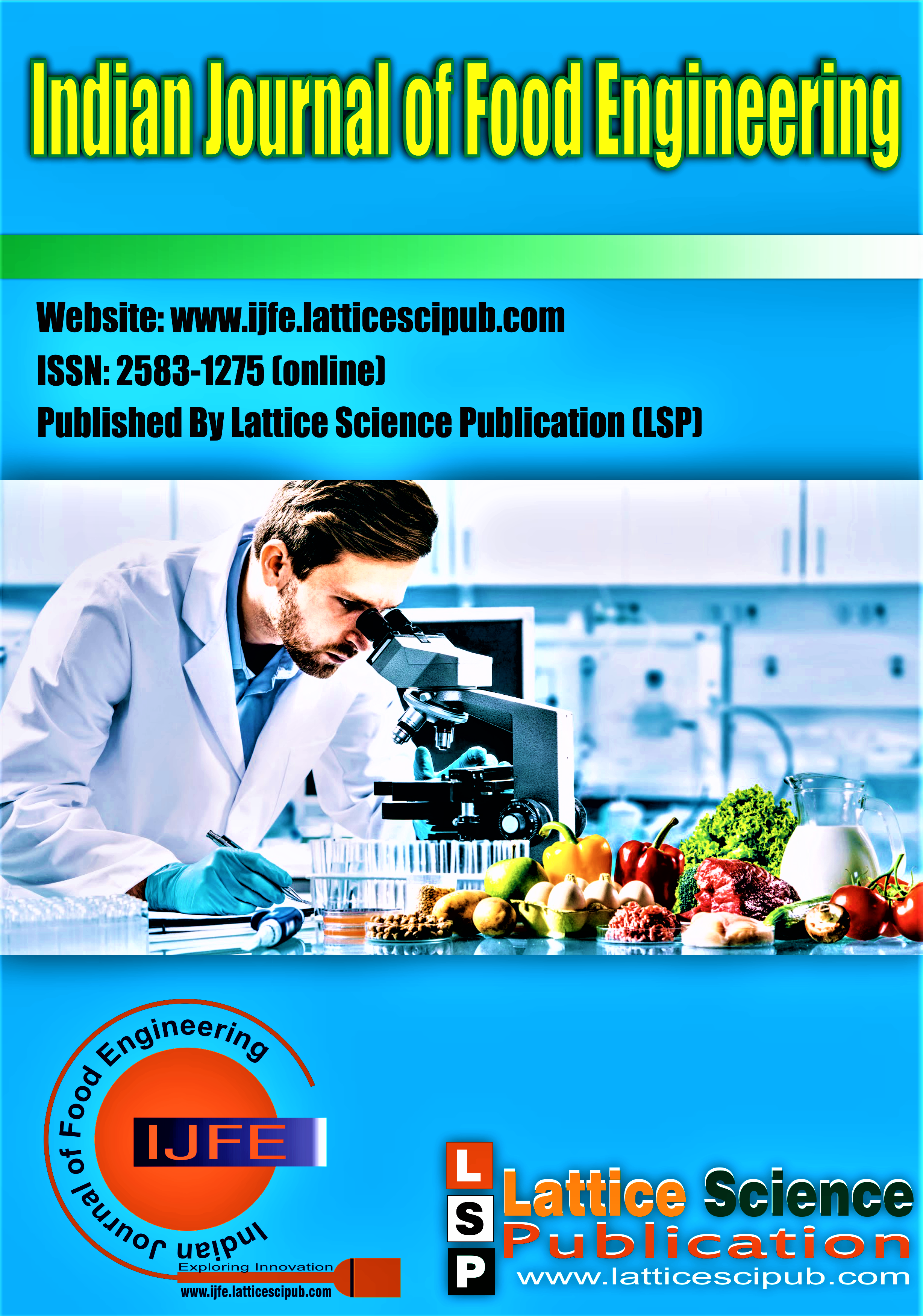Investigating the Impact of Microwave Drying on Papaya Slice Quality and Drying Attributes
Main Article Content
Abstract
Impact of microwave power and thickness of papaya slices were studied on the product quality and drying attributes of dehydrated papaya slices. Power (20, 40, 60 and 80W), thickness (3, 6 and 9mm), Moisture content, Vitamin’C’ and Iron content were determined and found i.e.M.c 24.23 to 13.25% w.b., Vitamin ‘C’ 45.55 – 45.38 mg/100g, Iron content 4 – 3.98 mg/100g. The quality and sensory attributes were determined, and it was found that the sample with the thickness of 3mm with 60W power was found highest score in overall acceptability with minimum loss of vitamin C and iron content. Drying rate, Rehydration Ratio, Ash Content were determined and found i.e., Drying Rate 0.0002 – 0.00025 g/s, Rehydration Ratio 1.85 – 1.08, Ash Content 1.80 – 1.02 %. In color parameters the product achieved dark color [L-22.48]at higher microwave power before acceptable dehydration. Where, as the sample dehydrated at slice thickness 3mm and microwave power 60 W scored acceptable color and sensory score as well as L (39.46), a (8.45) &b (15.23. The samples processed at 60 W microwaves drying had higher porosity than fresh samples analyzed by using SEM.Based on the criteria for thin-layer drying kinetics, the results reveal that, in comparison to the Henderson and Pabis, Lewis and Page model, the Singh and Wang model achieved the best values for the coefficient of determination (R2), chi-square (χ2), and reduced root-mean-square error approximation (0.01341).
Downloads
Article Details

This work is licensed under a Creative Commons Attribution-NonCommercial-NoDerivatives 4.0 International License.
How to Cite
References
Ela Singh, B.KalyaniB.Shasank Reddy. Osmatic Dehydration of papaya slices. [JOSR-J ESTFT]PP (2015). 72-95.
Feng,H and Tang J.Microwave finish drying of diced apple in spouted bed.Journal of Food Science. (1998),63(4):679-683 https://doi.org/10.1111/j.1365-2621.1998.tb15811.x
Forni E, Sormani A, Scalise S, Torreggiani D. The influence of sugar composition on the colour stability of osmodehydrofrozen intermediate moisture apricots. Food Res Int. (1997);30(2):87-94. https://doi.org/10.1016/S0963-9969(97)00038-0
Mandala I.G, E.F.Anagnostars and C.K. Influence of osmatic dehydration conditions on papaya air drying kinectics and their quality characterstics. Journal of Food Engineering, (2006).69, 306–317. https://doi.org/10.1016/j.jfoodeng.2004.08.021
Okpala LC, Ekechi CA. Rehydration characteristics of dehydrated West African pepper (Piper guineense) leaves. Food Sci Nutr. (2014); 2(6):664-8. https://doi.org/10.1002/fsn3.149
Pandya, Rushikesh & Chandra Yadav, Kailash. Study on Effect of Pretreatments and Microwave Drying On Banana Chips. IOSR Journal of Agriculture and Veterinary Science (IOSR-JAVS) (2014). e-ISSN: 2319-2380, p-ISSN: 2319-2372. Volume 7, Issue 7 Ver. IV (July. 2014), PP 04-10 https://doi.org/10.9790/2380-07740410
Sharma, Ragini & Chandra Yadav, Kailash. Study on Effect of Microwave Drying on Drying and Quality Characteristics of Guava (Psidiumguajava). International Journal of Scientific Engineering and Technology.(2017). 6. 150. 10.5958/2277-1581.2017.00007.9. https://doi.org/10.5958/2277-1581.2017.00007.9
Schiffman. Combined Hot Air, Microwave, and Infrared Drying of Hawthorn Fruit: Effects of Ultrasonic Pretreatment on Drying Time, Energy, Qualitative, and Bioactive Compounds’ Properties. (1992)
Shivam Salunke, Kailash Chandra Yadav and ShahajiKadam. Effect of microwave drying on drying and quality characteristics of banana chips. ournal of Pharmacognosy and Phytochemistry; (2019) 8(2): 2031-2036
Wang, J., and Y. Chao. Drying characteristics of irradiated papaya slices. Journal of Food Engineering, (2003). 52(1),83–88. https://doi.org/10.1016/S0260-8774(01)00090-5
Udomkun P, Argyropoulos D, Nagle M, Mahayothee B, Oladeji AE, Müller J. Changes in microstructure and functional properties of papaya as affected by osmotic pre-treatment combined with freeze-drying. J Food Meas Charact. (2018).;12:1028–37 https://doi.org/10.1007/s11694-018-9718-3
Yaldız, O., & Ertekin, C. Thin layer solar drying of some different vegetables. Drying Technology, (2001).19(3), 583–596 https://doi.org/10.1081/DRT-100103936
Zhang and Xu (2003). Mathematical modeling on thin layer microwave drying of papaya pomace with and without hot air pre-drying. Journal of Food engineering .doi:10.1016/j.jfoodeng.(2006).06.019.
Stephen, S. E. A., & E, V. Kumar. (2020). Optimization of Osmo- Dehydration Process of Honey Ginger Candy by using Response Surface Methodology. In International Journal of Engineering and Advanced Technology (Vol. 9, Issue 4, pp. 984–986). https://doi.org/10.35940/ijeat.c5353.049420
Optimizing Dehydration Conditions of Cow’s and Goat Milk Yogurt Powder. (2020). In International Journal of Innovative Technology and Exploring Engineering (Vol. 9, Issue 3S, pp. 68–71). https://doi.org/10.35940/ijitee.c1015.0193s20
Mittal, S., & R, V. (2022). Microwave Photonics Advancements in Radar Application. In International Journal of Recent Technology and Engineering (IJRTE) (Vol. 11, Issue 3, pp. 35–40). https://doi.org/10.35940/ijrte.c7227.0911322
Yadav, Dr. K. C., Karhale, H. B., & Singh, Prof. (Dr. ) M. (2023). Food Extrusion: A Highly Popular Technology to Process. In Indian Journal of Food Engineering (Vol. 2, Issue 3, pp. 1–8). https://doi.org/10.54105/ijfe.c1005.062323
P S, S., & V.A, Dr. H. (2023). Agriculture Distress and Farmers’ Suicide in Kerala in the Globalization Era. In Indian Journal of Agriculture Engineering (Vol. 3, Issue 2, pp. 1–7). https://doi.org/10.54105/ijae.b1510.113223





